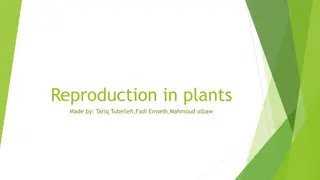Factors Affecting Puberty and Reproduction in Animals
An animal reaches puberty when it can release gametes and exhibit complete sexual behavior. Puberty age varies across species, influenced by factors like breed, climate, nutrition, and management. Smaller species generally reach puberty earlier than larger ones. Climatic conditions and genetics also play a role in puberty onset. Seasonality affects reproductive cycles, with short-day breeders being active in winter and long-day breeders in summer.
Uploaded on Sep 15, 2024 | 0 Views
Download Presentation

Please find below an Image/Link to download the presentation.
The content on the website is provided AS IS for your information and personal use only. It may not be sold, licensed, or shared on other websites without obtaining consent from the author.If you encounter any issues during the download, it is possible that the publisher has removed the file from their server.
You are allowed to download the files provided on this website for personal or commercial use, subject to the condition that they are used lawfully. All files are the property of their respective owners.
The content on the website is provided AS IS for your information and personal use only. It may not be sold, licensed, or shared on other websites without obtaining consent from the author.
E N D
Presentation Transcript
Dr Bhavna Asstt. Prof. Deptt. Of VGO
An animal has reached puberty when it is able to release gametes (sperms in males and ovum in females) and to manifest complete sexual behaviour. Age of first appearance of estrus. At puberty, secondary sexual characters becomes quite conspicuous and animal is able to reproduce.
Reproductive organs increases in size and are able to show external symptoms in one way or other depending upon the species of animal. Gonads functions i.e. hormone production and formation of gametes. also shows specific or characteristic Enhanced gonadal functions are stimulated by anterior affecting the reproductive cycle. pituitary gonadotrophins and thus,
Age at puberty Age at puberty Rabbits 3-4 months Sheep, Goat and Swine 6-7 months Cattle 12 months Horses 15-18 months
Early conception Early lactation/production Increased lifetime reproductive rate
Factors affecting puberty Factors affecting puberty 1. Breed 2. Climatic conditions 3. Season 4. Sex of animal 5. Level of nutrition 6. Management
Generally species of smaller size experience puberty at early age as compared to species of larger size. Genetic makeup do affects the age of puberty, particularly in exotic breed animals. Zebu cattle generally comes in estrus at later stage as compared to exotic and crossbred animals.
Climatic relative humidity, day length etc affects the age of puberty in all species. conditions like temperature, Puberty earlier as compared to animals which live in cold conditions. in tropics occurs generally
There are seasonal variations in some species of animals with respect to occurrence of puberty and reproductive cycle. Short day breeders shows estrous when day length is short (winter) where as other species are long day breeders (summer).
Generally, females of all species of animals show puberty counterparts. earlier as compared to their male Gonadal hormones are comparatively more active in females as compared to the males of same age. as well as anterior hypophysis
Animals maintained on high plane of nutrition show puberty at early age as compared to poorly fed animals. Imbalanced ration can affect the reproductive cycle in both males as well as females resulting in loss of reproductive cycle, thus delayed puberty.
Maintenance/up keep of animals, feeding etc. Detection of estrus at proper time. * Lack of proper estrus detection in animals will result in great financial loss.
Reproductive pattern of animals varies greatly in their natural habitat as compared to highly accustomed and protected environment. Under domestic environment, tends toward a pattern which causes the young one to be delivered temperature and feed availability is optimum. at the time of year, when
All changes in the ovarian activity but the degree of ovarian activity or inactivity is influenced by many factors like day length, nutrition, presence of male etc. females show seasonal cyclic environmental temperature,
Deliver young ones at the optimum time of year Seasonally polyestrous, breeding season length is such that young ones are born in spring.
Seasonally monoestrous Estrus throughout the year. occurs regularly Seasonality is discrete. In cattle, minimal fertility occurs maximum in November. in June and In sow, fertility is lower in summer and also, the litter size is smaller.
The influences of season, feed supply and other environmental factors on reproductive pattern of animals are more pronounced in females. There is quiescence/inactivity of male gonads and sometimes leading to cessation of spermatogenesis and also gonadal hormonal production. Wild animals show a marked breeding seasonal activity and have a quite prominent breeding activity during such period, often called as rutting rutting. .
Silent ovulatory cycles always occur at the beginning as well as end of the breeding season. Goats have a very well defined sexual season in temperate climates.
1. Light 2. Temperature 3. Feed supply 4. Psychological factors
Seen mostly in short (sheep) and long (mare) day breeders. In northern hemisphere of USA, ewes breed in the fall months such as September to November and five months later delivers the lamb in spring season. If these ewes are transported to southern hemisphere, most of these will reverse their breeding pattern and start breeding during March to April.
Artificial manipulation of light in a closed environment will cause the ewes to breed when the length of day light hours are declining. Birds and mares respond to lengthening of day light hours.
Light stimulus Retina Optic nerves Hypothalamus in CNS GnRH Anterior pituitary Gonads
Less clear than light. Plays a major role in the regulation of sexual function in lower vertebrates, particularly reptiles. Protection of ewes from higher summer temperature favours an early onset of breeding season. Sperm output, sperm motility and farrowing rate are severely lowered when boars are submitted to summer temperatures (35 C).
An enhanced diet increases vigour particularly in herbivorous and omnivorous animals. Ovaries show increased activity regardless of state of reproduction. Monotoccous species (cow and mare) experience same ovarian response but the polytoccous species (sow) respond to increased nutrient intake by shedding more ova. * Flushing (providing increased quantity and good quality of nutrients) litter size can be increases the chances of twinning and triplets.
Closely related. Male may refuse to copulate in an unnatural environment New environment often increases its reproductive potential. Addition of a ram to a flock of ewes in the late summer will hasten the onset of breeding by several days. Recorded voice of boar is found to be quite effective in sows.
Spontaneous ovulators Seasonal breeders Non-seasonal breeders Polyestrous Eg. Mare, Ass (spring) Ewe, Goat (onset of winter) Monoestrous Eg. Bitch Continuous breeeders Eg. Cow, Sow, Guinea pig, Monkey, Rat
Induced ovulators Seasonal breeders Non-seasonal breeders Eg. Cat, Ferret and wild rabbit Eg. Lab rabbit























